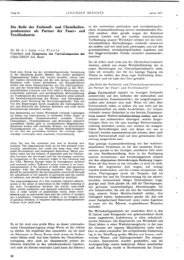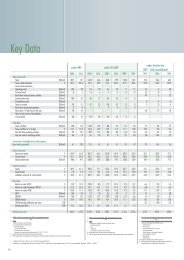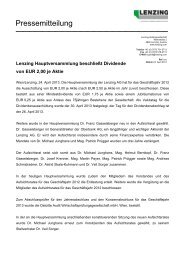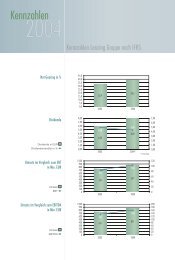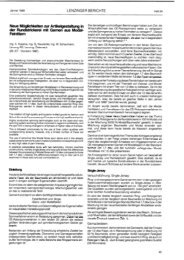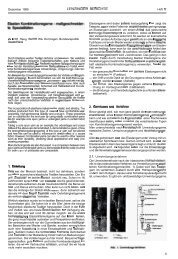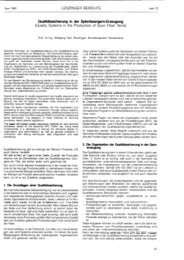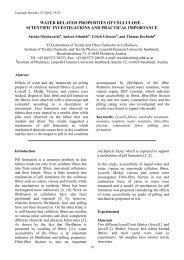Correlation of regenerated fibres morphology and surface ... - Lenzing
Correlation of regenerated fibres morphology and surface ... - Lenzing
Correlation of regenerated fibres morphology and surface ... - Lenzing
You also want an ePaper? Increase the reach of your titles
YUMPU automatically turns print PDFs into web optimized ePapers that Google loves.
<strong>Lenzing</strong>er Berichte, 82 (2003) 83-95<br />
molecule [14]. Therefore one can determine the<br />
polar <strong>and</strong> disperse part <strong>of</strong> the <strong>surface</strong> free<br />
energy measuring the contact angle between a<br />
solid <strong>and</strong> several liquids <strong>of</strong> different polarity<br />
[14,27].<br />
Material <strong>and</strong> methods<br />
Fibres <strong>and</strong> <strong>fibres</strong> treatment processes<br />
One solvent spun cellulose fibre (<strong>Lenzing</strong><br />
Lyocell - CLY) <strong>and</strong> two conventional cellulose<br />
<strong>fibres</strong> made by the viscose process (<strong>Lenzing</strong><br />
Viscose CV <strong>and</strong> <strong>Lenzing</strong> Modal CMD) were<br />
investigated <strong>and</strong> are summarized in Table 1.<br />
The <strong>fibres</strong> were treated using a Turbomat Ahiba<br />
laboratory dyeing apparatus according to the<br />
processes conventionally used in textile praxis<br />
(Table 2). The alkaline treatment was<br />
performed without any tension on the <strong>fibres</strong><br />
(usually called slack mercerisation); we will<br />
refer to it as “mercerisation”.<br />
Fibre type Viscose Modal Lyocell<br />
Symbol CV CMD CLY<br />
Linear density 1.88 1.78 1.82<br />
Tt [dtex] ±0.15 ±0.23 ±0.3<br />
Fibre length 39.9 40.1 39.4<br />
l [mm]<br />
±0.51 ±0.33 ±0.44<br />
Fibre diameter 14.3 14.2 12.8<br />
d [µm]<br />
±1.39 ±1.10 ±1.00<br />
Density 1.5045 1.5141 1.5205<br />
ρ [g/cm 3 ]<br />
Degree <strong>of</strong> polymerisation<br />
DPη<br />
Molecular<br />
mass Mη<br />
235<br />
±5.13<br />
38.000<br />
±880<br />
507<br />
±3.61<br />
82.100<br />
±540<br />
642<br />
±4.58<br />
104.000<br />
±730<br />
Table 1. The specifications <strong>of</strong> investigated <strong>regenerated</strong><br />
cellulose <strong>fibres</strong><br />
X-Ray analysis<br />
The influence <strong>of</strong> different treatment processes,<br />
e.g. bleaching <strong>and</strong> slack mercerising (alkaline<br />
treatment), on the structural changes in<br />
different types <strong>of</strong> <strong>regenerated</strong> cellulose <strong>fibres</strong><br />
was investigated by means <strong>of</strong> x-ray analysis,<br />
the procedure is described in detail in several<br />
references [24,1,6,2,29,34,35]. Ni filtered<br />
copper radiation from a conventional x-ray tube<br />
85<br />
(50 kV / 45 mA) was used in all scattering<br />
experiments.<br />
Bleaching Alkaline treatment<br />
6 ml/l H2O2 40 g/l NaOH<br />
2 ml/l Tanatex Geo 7 ml/l Tanawet BC<br />
(mineral stabilizer for (wetting agent,<br />
H2O2 stabilization) anionic)<br />
pH = 10.7 pH = 12.8<br />
t = 30 min t = 1 min<br />
T = 98° C T = 10°C<br />
Table 2. Conditions <strong>of</strong> the treatment processes -<br />
bleaching <strong>and</strong> slack mercerisation (alkaline treatment<br />
without tension)<br />
Determination <strong>of</strong> the long spacing by small<br />
angle x-ray scattering (SAXS). SAXS intensity<br />
curves were measured using a Kratky camera<br />
with a slit collimation using a PSD position<br />
sensitive detector counting scattered intensity in<br />
the meridional direction, i.e. parallel to the fibre<br />
axis. The experimental data was corrected for<br />
absorption <strong>and</strong> background scattering <strong>and</strong> long<br />
spacing was determined applying Bragg’s law:<br />
n.λ<br />
L = (1)<br />
2.sinθ<br />
where L is the long spacing, n order <strong>of</strong><br />
reflection, λ wavelength <strong>of</strong> x-rays <strong>and</strong> θ<br />
Bragg’s scattering angle.<br />
Determination <strong>of</strong> the crystallinity index <strong>and</strong><br />
crystalline orientation by wide-angle x-ray<br />
scattering (WAXS). A two-circle goniometer<br />
equipped with a linear position sensitive<br />
detector (PSD was used to measure the twodimensional<br />
WAXS scattering diagrams<br />
(azimuthal angular range from 0° to 180° in<br />
steps <strong>of</strong> 5°). The full pattern after the<br />
subtraction <strong>of</strong> the background scattering <strong>and</strong> the<br />
absorption <strong>and</strong> some steps <strong>of</strong> the evaluating<br />
procedure for one <strong>of</strong> the analysed <strong>fibres</strong> are<br />
presented in Figure 1.<br />
A weighted integration <strong>of</strong> the two dimensional<br />
diagram (Eq.2) was performed to obtain a<br />
„r<strong>and</strong>omized“ scattering I(2θ) curve, which was<br />
corrected for Compton scattering.



